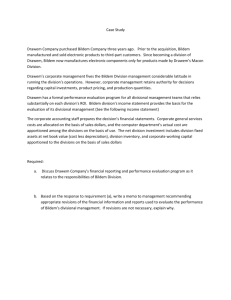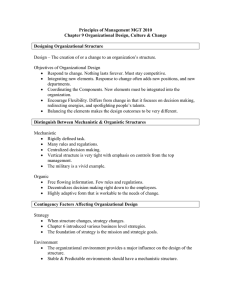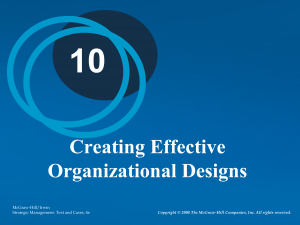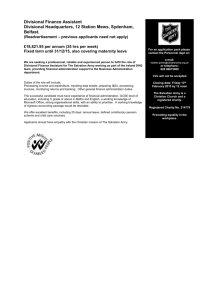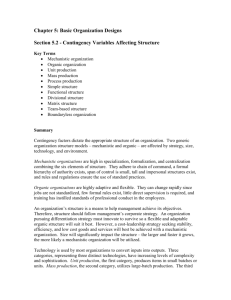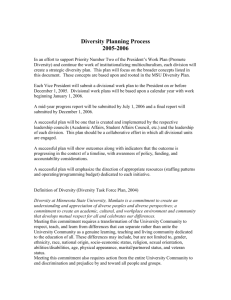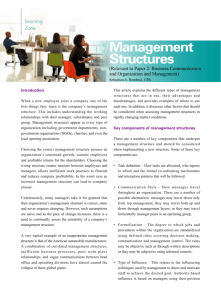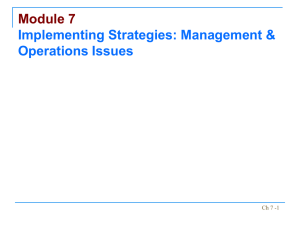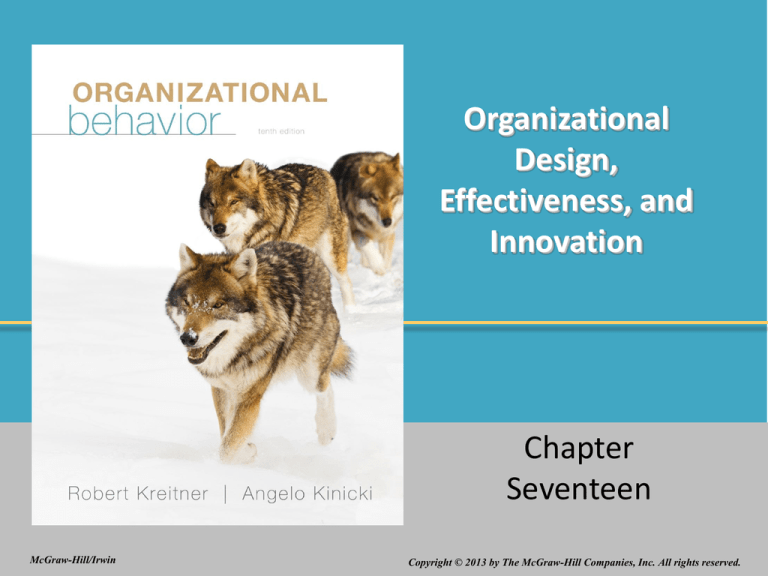
Organizational
Design,
Effectiveness, and
Innovation
Chapter
Seventeen
McGraw-Hill/Irwin
© 2013
The McGraw-Hill Companies, Inc. All rights reserved.
Copyright © 2013 by The McGraw-Hill Companies, Inc. All rights reserved.
Organization Charts
Organization chart
a graphic
representation of
formal authority and
division of labor
relationships
17-2
Dimensions of an
Organizational Structure
Hierarchy
of
authority
Division
of labor
Spans of
control
Line and
staff
positions
17-3
Sample Organization Chart for a
Hospital
17-4
Organization Charts
Span of control
the number of people reporting directly to a
given manager.
Generally, the narrower the span of control, the
closer the supervision and the higher the
administrative costs as a result of a higher
manager-to-worker ratio.
17-5
Organization Charts
Staff personnel
Do background
research and provide
technical advice, and
recommendations to
line managers.
Line Managers
have authority to
make
organizational
decisions.
17-6
An Open-System Perspective
Closed System
self-sufficient entity, closed to the surrounding
environment.
Open System
depends on constant interaction with the
environment for survival
17-7
The Organization as an Open System
17-8
Organization Design
Organizational design
The structures of accountability and
responsibility used to develop and implement
strategies, and the human resource practices
and information and business processes that
activate those structures
17-9
Traditional Design
Functional structure
groups people according to the business
functions they perform, for example,
manufacturing, marketing, and finance
Divisional structure
groups together activities related to outputs,
such as type of product or customer
17-10
Traditional Design
Matrix structure
combines functional
and divisional chains
of command to form
a grid with two
command structures
17-11
Matrix Structure
17-12
Principles for Designing a
Horizontal Organization
1.
2.
3.
4.
5.
Organize around complete workflow processes
Flatten hierarchy and use teams to manage
everything
Appoint process team leaders to manage internal
team processes
Let supplier and customer contact drive
performance
Provide required expertise from outside the team
as required
17-13
Designs That Open Boundaries
between Organizations
Hollow structure
organization identifies core competencies and
outsources noncore processes to vendors who
can do them cheaper or faster
Modular structure
Outsources parts of a product instead of
processes
17-14
Question?
Chad has developed a new product to
improve gas mileage. He has formed a new
venture but must outsource his marketing and
distribution. His firm has a _________
organization.
A.Functional
B.Divisional
C.Matrix
D.Hollow
17-15
Designs That Open Boundaries
between Organizations
Virtual organization
organization identifies partners with the needed
talents and negotiates an agreement in which
the participants typically work in separate
facilities, linked by technology
17-16
The Contingency Approach to
Designing Organizations
Contingency approach to organization
design
organizations tend to be more effective when
they are structured to fit the demands of the
situation
17-17
Mechanistic versus Organic
Organizations
Mechanistic organizations
Rigid bureaucracies with strict rules, narrowly
defined tasks, and top-down communication.
Organic organizations
Flexible networks of multitalented individuals
who perform a variety of tasks
17-18
Characteristics of Mechanistic and
Organic Organizations
17-19
Different Approaches to
Decision Making
Centralized decision making
key decisions are made by top management
Decentralized decision making
important decisions are made by middle- and
lower-level managers
17-20
Getting the Right Fit
A functional structure can save money by
grouping together people who need similar
materials and equipment
Divisional structures increase employees’
focus on customers and products
17-21
Getting the Right Fit
A successful matrix structure requires superior
managers who communicate extensively,
foster commitment and collaboration, manage
conflict and negotiate effectively to establish
goals and priorities
consistent with the
organization’s strategy
17-22
Getting the Right Fit
Horizontal designs improve coordination
and communication
Organizations that become hollow,
modular, or virtual can generate superior
returns by focusing on what they do best
17-23
Question?
Oneal, CEO of Fredhandbag HobbyTown,
wants to improve the communication in his
firm. He should change to a _________
organization.
A.Functional
B.Matrix
C.Horizontal
D.Modular
17-24
Four Dimensions of Organizational
Effectiveness
17-25
Generic Effectiveness Criteria
Internal processes
focuses on “what the organization must excel
at” to effectively meet its financial objectives
and customers’ expectations.
Strategic constituencies satisfaction
Strategic constituency: any group of people
with a stake in the organization’s operation or
success.
17-26

